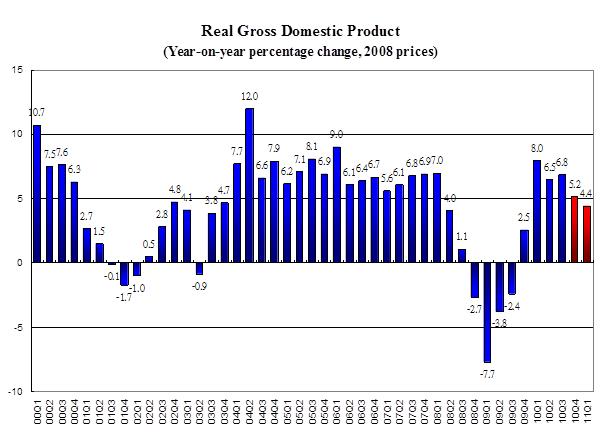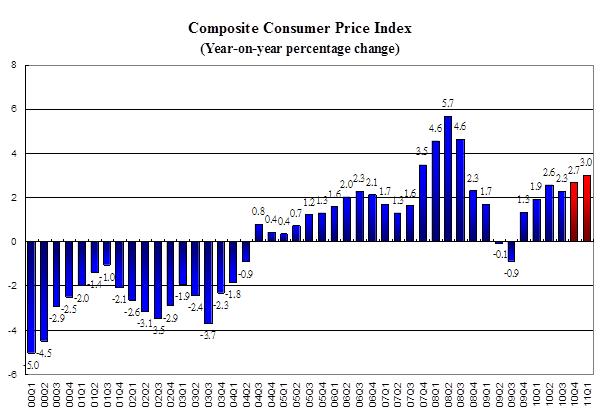Media
HKU Announces 2011 Q1 HK Macroeconomic Forecast
05 Jan 2011
Hong Kong Economic Outlook
The APEC Studies Programme of the Hong Kong Institute of Economics and Business Strategy at the University of Hong Kong (HKU) released its quarterly Hong Kong Macroeconomic Forecast today (Jan 5). According to its High Frequency Macroeconomic Forecast, real GDP is estimated to increase by 5.2% in 10Q4 when compared with the same period last year. This estimate is an upward revision from the previous forecast of a 4.8% growth released on October 6, 2010, reflecting a stronger growth in private consumption.

Professor Richard Wong Yue-Chim, Professor of Economics at HKU said that, "In the third quarter of last year, Hong Kong's economy had fully recovered from the setback caused by the turmoil in the global financial market triggered by the sub-prime mortgage crisis more than two years ago. Real GDP is estimated to grow by 6.0% in the second half of last year, moderating from the 7.2% increase in the first half. For the year as a whole, real GDP is forecast to increase by 6.6%. The growth in real GDP is driven primarily by domestic demand. The increase in domestic demand is estimated to account for 5.5 percentage points of the 6.6% overall increase in real GDP in the current year, with external demand accounting for the rest of the growth. In the current quarter, real GDP growth is forecast to moderate to 4.4% when compared to the same period last year, due to a less supportive external environment."
"The job market is expected to be stable with the unemployment rate projected to be at 4.0% in both 10Q4 and 11Q1. The headline inflation is forecast to reach 3% in the current quarter, up from the 2.4% recorded in last year. Nominal wage growth has lagged behind consumer inflation, resulting in falling real wage. Inflation is expected to be a big challenge this year with the headline rate creeping up continuously," according to Dr. Alan Siu, Executive Director of the Hong Kong Institution of Economics and Business Strategy at HKU.
The forecast details are in Table 1, Table 2, and Table 3 (selected mont hly indicators) of the full report at: http://www.hiebs.hku.hk/apec/macroforecast.htm.
All growth rates reported are on a year-on-year basis.
Forecast Highlights
-
Private consumption spending grew by 5.7% in 10Q3, up from the 4.4% growth in 10Q2. This stronger consumption growth was fueled by a stable job market and rising asset prices. Falling real wages dampens further consumption growth with the growth in private consumption expenditure estimated to grow by 4.7% in 10Q4 and moderate further to 4.3% in 11Q1. For the last year as a whole, private consumption spending is forecast to grow by 5.4%, accounting for half of the total GDP growth for the year of 2010.
-
The volume of retail sales increased by 15.6 % in 10Q3, buoyed by strong domestic demand and the influx of Mainland visitors. In November, the volume grew 15.2% and the momentum is projected to continue. The growth in the volume of retail sales is estimated to be 15.5% in 10Q4 and moderate to 12.0% in 11Q1. It is projected to grow by 15.1% last year.
-
Exports of goods surged by 20.8% in 10Q3, doing slightly better than the 20.1% growth in 10Q2. In November 2010, the total value of exported goods recorded 16.6% growth in nominal terms. Double-digit nominal growth rates were recorded in all major destination countries, with 18.6%, 14.9 and 10.0% growth to China, USA and Japan respectively. But the real growth in the exports of goods will be substantially lower due to rising export prices reflecting the general weakness of the US dollar. Exports of goods is estimated to grow by 11.3% in real terms in 10Q4, and moderate further to 8.0% in the current quarter. For the last year as a whole, the exports of goods is estimated to increase by 18.2%.
-
Imports of goods increased by 16.5% in 10Q3, decelerating from the 23.6% growth in 10Q2. This slowdown is projected to continue due to rising import prices brought on by the appreciation in RMB and the Japanese Yen. Imports of goods is estimated to grow only by 8.5% in 10Q4 and further decelerate to 4.5% in 11Q1. For the year of 2010 as a whole, it is projected to grow by 18.4%.
-
Service exports grew by 14.0% in 10Q3, decelerating from the 17.1% growth in 10Q2. The slowdown in the external trade of goods will drag down the demand for trade related services, but strong inbound tourism due to the influx of Mainland visitors will provide support for continuous growth in service exports. Visitor arrivals rose by 17.1% in November 2010, with Mainland visitors accounting for 12.8 percentage points of the 17.1% overall growth. The increase in service exports is forecast to be 9.2% in 10Q4 and moderate to 7.6% 11Q1. The annual growth of 2010 is estimated to be 14.2%.
-
Service imports went up by 9.9% in 10Q3, decelerating from the 12.4% growth in 10Q2. Service imports is forecast to grow by 4.2% and 3.4% in 10Q4 and 11Q1 respectively. It is estimated to grow by 9.2% in the whole year of 2010.
-
Gross fixed capital formation grew only by 0.3% in 10Q3 which is a sharp turnaround from the 15.6% growth in 10Q2 due to a sizeable decrease in machinery and equipment investment. Infrastructural projects will be the driver for investment spending. Gross fixed capital formation is projected to grow by 6.9% in 10Q4 and 6.8% in 11Q1. The annual growth of 2010 is estimated to be 7.5%.
-
Investment in land and construction rose by 14.7% in 10Q2. With the commencement of Kai Tak cruise terminal development project along with other ongoing major infrastructural projects, the growth momentum is expected to continue. Investment in land and construction growth is projected to be 5.9% in 10Q4 and accelerate to 7.8% in the current quarter. The annual growth of 2010 is estimated to be 8.3%.
-
Investment spending in machinery, equipment and computer software dropped by 6.4% in the 10Q3 after three consecutive quarters of double-digit growth, and is projected to increase by 7.8% in 10Q4 and 6.0% in 11Q1 when compared with the same period last year. It is projected to increase by 6.8% for the year of 2010 as a whole.

-
The general price level, as measured by the Composite CPI, rose by 2.9% in November 2010. If there were no fiscal measures, the price index would increase by 2.6%. Imported inflation arising from RMB appreciation, rising energy prices and loose monetary conditions will continue to push the general price level up in Hong Kong, with bigger rises in food prices and private rental rates. The headline consumer inflation rate is forecast to be 2.7% in 10Q4, and pick up further to 3.0% in the current quarter. For the last year as a whole, the headline consumer inflation is estimated to be 2.4%, as compared to the 0.5% increase in 2009.

-
The provisional seasonally adjusted unemployment rate improved slightly to 4.1% in the three months ending in November 2010 from 4.2% in the three months ending in October 2010. The unemployment rate is forecast to be at 4.0% both in 10Q4, and 11Q1. In the current quarter, the numbers of employed and unemployed workers in 11Q1 are estimated to be 3.53 million and 147,000 respectively. For the last year as a whole, the unemployment rate is estimated to average out to be 4.3%.
Concluding Remarks
Hong Kong's real GDP bounced back from the 2.8% contraction in 2009 to an estimated growth of 6.6% which is above its trend rate of growth. This turnaround is due to the recovery of the developed economies and the more than 10% growth in the Mainland economy. As the deleveraging process is still on-going, consumption growth in the developed world will remain anemic as households will continue to cut back their spending to build up their buffers of precautionary savings. This will dampen the growth in external trade. The growth in the Mainland economy will likely to be slower this year due to a projected tightening in credit expansion and a rebalancing of the economy towards domestic consumption. Given this external environment which is less supportive for growth, Hong Kong's real GDP is projected to grow more slowly in the current year between 4% to 5%, with the headline inflation rate creeping up to 4% by year-end. A major risk factor is the on-going sovereign debt crisis in some members of the European Union which might unsettle the global financial market and derail global economic growth.
About Hong Kong Macroeconomic Forecast Project
The Hong Kong Macroeconomic Forecast is based on research conducted by the APEC Studies Programme of the Hong Kong Institute of Economics and Business Strategy at HKU in the Faculty of Business and Economics. It aims to provide the community with timely information useful for tracking the short-term fluctuations of the economy. The current quarter marco forecasts have been released on a quarterly basis since 1999.
The high frequency forecasting system was originally developed in collaboration with Professor Lawrence Klein of the University of Pennsylvania in 1999-2000. Since then, the system has been maintained and further refined by the APEC Study Center which is now a research programme area of the Hong Kong Institution of Economics and Business Strategy.
The project is sponsored by the Faculty of Business and Economics. The Hong Kong Centre for Economic Research at HKU provides administrative support to the project. Researchers at the Hong Kong Institution of Economics and Business Strategy are solely responsible for the accuracy and interpretation of the forecasts. Our quarterly forecasts can be accessed at:
http://www.hiebs.hku.hk/apec/macroforecast.htm
For media enquiries, please contact Ms Trinni Choy, Assistant Director (Media)(Tel: 2859 2606/Email: pychoy@hku.hk), or Ms Melanie Wan, Manager (Media) (Tel: 2859 2600/Email: melwkwan@hku.hk), Communications & Public Affairs Office, HKU.
|
Picture 1 |
Picture 2 |
